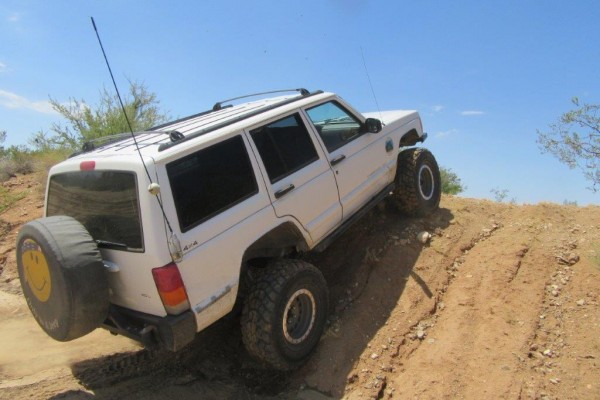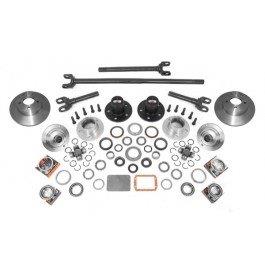When Mike Barnes bought new tires for his 1997 Jeep Cherokee, he had no idea that the increased traction of the Yokohama Geolandar M/T tires might cause a weak link in his Cherokee’s driveline. He later found out from fellow club members that the enhanced traction of the Yokohama Geolandar M/T has almost eliminated the use of selectable lockers.
While many tires will see a loss of traction when they’ve experienced extended tread mileage, Geolandar M/T tires feature a directional tread pattern for outstanding, long-lasting traction and easier clean-out. Plus, the tires have extra sidewall ribs, an advanced tread compound, and a step-block groove configuration to increase their surface area. The increased traction is great, but it can also lead to twisted or broken front axles, broken axle U-joints, and other potential issues if the 20-year-old OEM axles aren’t updated.
Barnes decided to preempt any possible problems by swapping in a chromoly front axle and manual (freewheeling) hub kit. Freewheeling hubs allow you to manually engage and disengage your front axle, so you can get four-wheel drive traction when you need it. They were offered as options by four-wheeler manufacturers for decades, but were all but phased out in favor of full-time four-wheel-drive transfer cases and, eventually, selectable transfer cases. Nowadays, hubs on new vehicles are rare, but they can still provide many benefits, especially if your Jeep is your daily driver. These benefits include improved highway gas mileage, reduced front driveline wear and tear, easier steering effort, and reduced front tire wear in some cases.
Alloy USA’s Manual Locking Hub Conversion Kit for 1984-06 Jeep Cherokee/Wrangler was the perfect choice to convert Barnes’ Dana 30 to freewheeling. The conversion kit comes with new, very strong front axles, U-joints, bearings, seals, and brake rotors. (Please make note: This kit is for the Dana 30; it won’t work on a Rubicon Dana 44 axle.) Installing the conversion kit is not an easy two-hour task that anyone can do at home. You’ll need sufficient experience, a full set of hand tools, and a floor jack and jack stands (or a lift). If you know what you’re doing, you can expect the installation to take six to eight hours.
Your first step is to thoroughly read the entire set of installation instructions; however, we had two additional steps that many of you won’t find necessary: Changing the differential cover and the fluid. We’ll be using Royal Purple Max-Gear (75W-140W) synthetic gear oil, which is a high-performance GL-4 and GL-5 automotive gear oil designed to provide maximum protection to heavily loaded gears. It outperforms many other oils and makes your gears run smoother, quieter, cooler, and longer without overhauls.
Not liking the OEM cover (which doesn’t have a drain hole), Barnes felt a new differential cover would improve the Jeep’s maintenance routine. The Rugged Ridge Boulder high-strength cast-aluminum differential cover is constructed from A356-T6 aluminum for impact resistance and features a precision-machined sealing surface, allowing gaskets or RTV sealant to be used for a leak-free seal. The cover is designed to help protect the internal components from damage caused by rocks and also helps dissipate heat from the differential.
You can follow the installation below:
Just before loading the Cherokee on the lift for the install, we drove an 80-mile loop on I-40 east out of Kingman, AZ for a mileage test. The route predominately climbs above Kingman’s 3,500-foot elevation but also covers rolling hills and fairly long flat stretches for 40 miles and then returns to Kingman in a reverse direction. Other than having no traffic, it’s an excellent repeatable route for mileage tests. The pre-conversion mileage was 15.1 mpg; while the post-conversion mileage was 16.6 mpg. Admittedly, this was a controlled test, so your results will vary, but it’s still a good indication of what your results will be.

































[…] Classifieds My Jeeps Saw this article and thought of this thread https://www.onallcylinders.com/2016/0…onversion-kit/ After looking through the pictures, it really makes me want a lift. So many projects would be so […]
Looks like I’ll need to change my rims. I run 01 Limited 16 in rims.